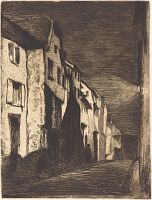Street at Saverne | ||
| Number: | 14 | |
| Date: | 1858 | |
| Medium: | etching and open bite or sandpaper ground | |
| Size: | 209 x 159 mm | |
| Signed: | 'Whistler' at lower left | |
| Inscribed: | 'Imp. Delatre. Rue St. Jacques' at lower right (2-3); erased (4) | |
| Set/Publication: | 'French Set', 1858 | |
| No. of States: | 4 | |
| Known impressions: | 81 | |
| Catalogues: | K.19; M.19; T.7; W.11 | |
| Impressions taken from this plate (81) | ||
KEYWORD
lamplight, lantern, nocturne, town, street.
TITLE
The titles all include the place, Saverne. The main variations concern whether the words 'Street' or 'Night' are included:
'Street at Saverne' (1858, Whistler). 2
'Saverne - night' (1874, Whistler). 3
'Street at Saverne – Night' (1874, James Anderson Rose (1819-1890)). 4
'Street at Saverne' (1874, Ralph Thomas, Jr (1840-1876)). 5
'Saverne' (1870s, Whistler).. 6
'Street at Saverne' is the original and generally accepted title. The later impressions undoubtedly show it as a night scene, but clearly Whistler's first intention was to specify the place, not the time.
By the 1870s he was beginning to use the title 'Nocturne' but although this was his first night scene it was never called 'Nocturne'. The first etchings to be given that title were in Venice in 1879/1880, in, for instance, Nocturne: Palaces [200].
'Street at Saverne' (1858, Whistler). 2
'Saverne - night' (1874, Whistler). 3
'Street at Saverne – Night' (1874, James Anderson Rose (1819-1890)). 4
'Street at Saverne' (1874, Ralph Thomas, Jr (1840-1876)). 5
'Saverne' (1870s, Whistler).. 6
'Street at Saverne' is the original and generally accepted title. The later impressions undoubtedly show it as a night scene, but clearly Whistler's first intention was to specify the place, not the time.
By the 1870s he was beginning to use the title 'Nocturne' but although this was his first night scene it was never called 'Nocturne'. The first etchings to be given that title were in Venice in 1879/1880, in, for instance, Nocturne: Palaces [200].
2: Douze eaux-fortes d'après Nature.
3: London Pall Mall 1874 (cat. no. 5).
4: Liverpool 1874 (cat. no. 506).
5: Thomas 1874 (cat. no. 7).
DESCRIPTION
A view up a street at night, with moonlight casting dramatic shadows on the row of steep-roofed buildings of varying heights to left. A single figure stands near a doorway half way down the street on the left. A lantern projects from a tall building on the right.
SITE
Saverne is a town in what is now the Bas-Rhin department of Alsace in north-eastern France. It commands a crucial crossing on the river Vosges. It is 45 km north-west of Strasbourg. Whistler's composition was based on a pencil and wash drawing, A street at Saverne [m0237], reproduced below.
DISCUSSION
Street at Saverne is Whistler's first etching of a night scene. Although never called a 'Nocturne', in some aspects of the technique and composition it prefigures later Nocturnes such as Nocturne: Palaces [200]. Street at Saverne was based on a sketch in pencil and watercolour, A street at Saverne [m0237]. It is the reverse of the drawing, which implies that Whistler copied or traced the drawing onto the copper plate. Thus the plate may have been etched back in Paris.
However, it has also been suggested that Whistler might have made use of the workshop and studio of the artist and etcher Ignace Schott de Dabo (1810-1883), who did much of his work in Saverne. He was the father of Leon Dabo and Theodore Scott Dabo who were admirers of Whistler's work in later years. Indeed Leon Dabo invented a closer relationship with Whistler than is born out by the facts, 'authenticating' and perhaps fabricating works by Whistler. The Pennells accepted and embroidered Dabo's account:
'Mr Leon Dabo tells us that his father was a fellow
student of Whistler's at Gleyre's and lived at Saverne, now Zabern, in
Alsace, and that it was to see him Whistler went there. And from Mr
Dabo we have the story of excursions that Whistler and Ernest made
with his father and several friends: one to the ruins of the castle
near the village of Dabo, now Dagsbourg, where it is said their
signatures may still be seen on a rock of brown sandstone; another to
Gross Geroldseck, and the sketches Whistler made there were afterwards
presented to the Zabern Museum. It may be that a third
excursion was to Pfalzburg, the birthplace of Erckmann and Chatrian,
whom Whistler knew and possibly then met for the first time.' 7
No works by Whistler have been found in the museum at Saverne.
No works by Whistler have been found in the museum at Saverne.
7: Pennell 1911 A, p. 43.


